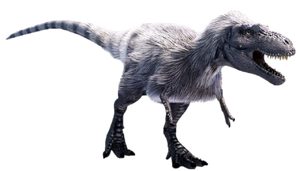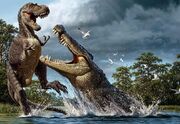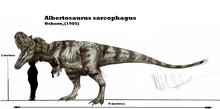Template:Featured article
| Albertosaurus | |
|---|---|

| |
| A restoration of Albertosaurus sarcophagus | |
| Scientific classification | |
| Kingdom: | Animalia |
| Phylum: | Chordata |
| Class: | Sauropsida |
| clade: | Dinosauria |
| Superorder: | Theropoda |
| Genus: | †Albertosaurus Osborn et al., 1905 |
| Species: | A. sarcophagus |
| Binomial name | |
| Albertosaurus sarcophagus Osborn et al., 1905 | |
| Synonyms | |
| |
Albertosaurus was an earlier relative to the better-known Tyrannosaurus are examples of large, late Tyrannosauridae family separated on two groups during the early Cretaceous period - Albertosaurinae and Tyrannosauridae. As one can see from its name, Albertosaurus was one of basal and most common Albertosaurines. Albertosaurinae had much more gracile and aerodynamic body design than Tyrannosaurinae. Their skulls were also far thinner and more flexible, and so possessed a somewhat weaker bite force. Albertosaurus lived in Canada during the Maastrichtian, 70 mya.
Description
Albertosaurus had especially thin skull compared to other larger Tyrannosaurids. Also, its teeth are not so well adapted for crunching bone, what's usual characteristic for Tyrannosaurids, but are much more suitable for slicing meat. It's also possible that Albertosaurus had some kind of 'septic bite'. We are not absolutely sure about this, but the edges of his teeth are serrated and very similar to edges of modern Komodo dragon. These tiny serrations on teeth are turned backwards, so, when this dinosaur bites something, small pieces of meat will stay between these serrations, and become home of some deadly bacteria, which may helped during killing prey.

The skull of an Albertosaurus.
Leg bones have very big act in running abilities and speed of animal. Fastest animals have metatarsal bones proportionally longer than so-called "upper leg" bones (tibia and femur). Also, to give more stability during running, tibia is slightly longer than the femur. Adult Albertosaurus was, according to length of leg bones, relatively fast animal, able to run about 40 miles per hour. However, juveniles had leg bones much more specialized for running, what indicates they were much faster than adults. According to amazing fossil sight from Red Deer river (Alberta, Canada), Albertosaurus hunted in groups with about 11 individuals. Both juveniles and adults participated in hunt. Juveniles gave speed, and adults gave strength.
The head of Albertosaurus had two small, blunt horns like the comb on a chicken today. It is possible that the male had brightly colored skin covering the horns to attract the female during mating season. It would be like birds today, with the males brightly colored to attract females.
Fossil remains of Albertosaurus are common, especially teeth, which often broken when it was feeding. Several species are recognized: Albertosaurus sarcophagus and Albertosaurus Libratus are the most common. Albertosaurus lancensis has been renamed Nanotyrannus. Some paleontologists think the theropod dinosaur Alectrosaurus Olsen from Mongolia is a species of Albertosaurus. If this is correct Albertosaurus lived in both North America and Asia. Albertosaurus may have hunted in packs. Albertosaurus could have hunted Albertaceratops.
History
Although the small flesh-eating dinosaurs were diverse and dangerous, Cretaceous Alberta was ruled by members of the family tyrannosauridae.

An artist's impression of Albertosaurus being attacked by Deinosuchus.
All tyrannosaurs had hind legs that were long and powerful, with each hind foot having three toes ending in enormous claws. The two-fingered front limbs were small, not much larger than a mature human arm. The function of the front limbs is not known.
Albertosaurus, the "lizard from Alberta," was among the most fearsome predators in Cretaceous Alberta. 9 meters long and 3 meters high at the hip, it is the most common of the large carnivores found here. Smaller but longer-limbed than T. rex, Albertosaurus would have been a mobile hunter. Like modern carnivores, it probably fed on the carcasses of already dead animals as well.
Albertosaurus weighed up to 3 tons yet may have been capable of attaining speeds of more than 40 mph. This fleetness, combined with obvious physical strength, would have made Albertosaurus a fierce hunter, but less than the more massive T. rex. Albertosaurus neck was strong and muscular, supporting a large but lightly built head. The teeth were long and recurved with saw-like edges, perfect for tearing flesh. They were not adapted for chewing, making it likely than Albertosaurus swallowed flesh in large chunks.

Albertosaurus bones were among the earliest dinosaur remains collected in Alberta. A skull found by J.B. Tyrrell in 1884 was the first important dinosaur fossil to be discovered along the Red Deer River. It was named in 1905, the same year that Alberta became a province. Since then, ma
ny Albertosaurus fossils have been discovered. the smallest documented Albertosaurus, a juvenile less than a quarter of the size of a full grown adult, was collected from Sandy Point on the South Saskatchewan River in 1986. [1]
J.B. Tyrrell spent most of his long career as a geologist, explorer and entrepreneur on the Canadian Shield. However, in 1884 his first field work was in Cretaceous strata along the Red Deer River where his discovery of a skull of the tyrannosaur Albertosaurus provided a name to the paleontological museum in Drumheller. At the time, several discoveries were made to what was 10 Albetosaurus species (Gorgosaurus, Deinodon, Tarbosaurus, Alectrosaurus, Dryptosaurus, Dinotyrannus/Tyrannosaurus) ; including the Nanotyrannus, Jane, by courtesy of von Huene, Riabinin, and most noticeably Gilmore, Matthew, Kuhn, Paul and Russell. But recent research proved that the other species were sperate genus, and there being only one genus of Albertosaurus.
In the media
- Albertosaurus has been a famous tyrannosaur for a long time. It was in the popular documentary Jurassic Fight Club in the episode "Biggest Killers" where it talks about the killing ability of Albertosaurus, and in the episode "River of Death", where it shows how a pack of Albertosaurus attacked a herd of Pachyrhinosaurus.
- It is also shown in the National Geographic special, March of the Dinosaurs, where a herd of Edmontosaurus are ambushed by a pack of Albertosaurus while the hadrosaurs are heading south during the frozen winter. One certain Albertosaurus chases the protagonist baby Edmontosaurus and his brain-tumored companion to the edge of a cliff, where both the Albertosaurus and the brain-tumored Edmontosaurus fall off the cliff to their deaths.
- Albertosaurus appeared in the final episode of Prehistoric Park.
- Albertosaurus is briefly mentioned in the tenth episode of Primeval's third series. An Albertosaurus appears in the first episode of Primeval: New World where it kills Evan Cross's wife. It reappears in the eighth episode of the series when Evan hallucinates after being sneezed on by a Pachycephalosaurus. It appears for the final time in the thirteenth and final episode where it rampages through London and later Vancouver before finally being slain by Evan. The theropod is depicted with horns and a missing arm.
- Albertosaurus is a teir 4 carnivore in the steam game, The Isle.
Gallery
Albertosaurus/Gallery
References
General Information Credits to "ROMTECH" Computer CD Dinosaur Discovery
History credits to http://www.cbv.ns.ca/marigold/history/dinosaurs/datafiles/albertosaurus.html and http://gsc.nrcan.gc.ca/paleochron/31_e.php
http://en.wikipedia.org/wiki/Albertosaurus
http://animals.howstuffworks.com/dinosaurs/albertosaurus.htm
http://www.prehistoric-wildlife.com/species/a/albertosaurus.html
http://archaeology.knoji.com/albertosaurus-the-tyrants-cretaceous-cousin/
http://www.absoluteastronomy.com/topics/Albertosaurus
http://www.enchantedlearning.com/subjects/dinosaurs/dinos/Albertosaurus.shtml
Documentaries:
Jurassic Fight Club
March of the Dinosaurs
Dino Gangs
Prehistoric Park












